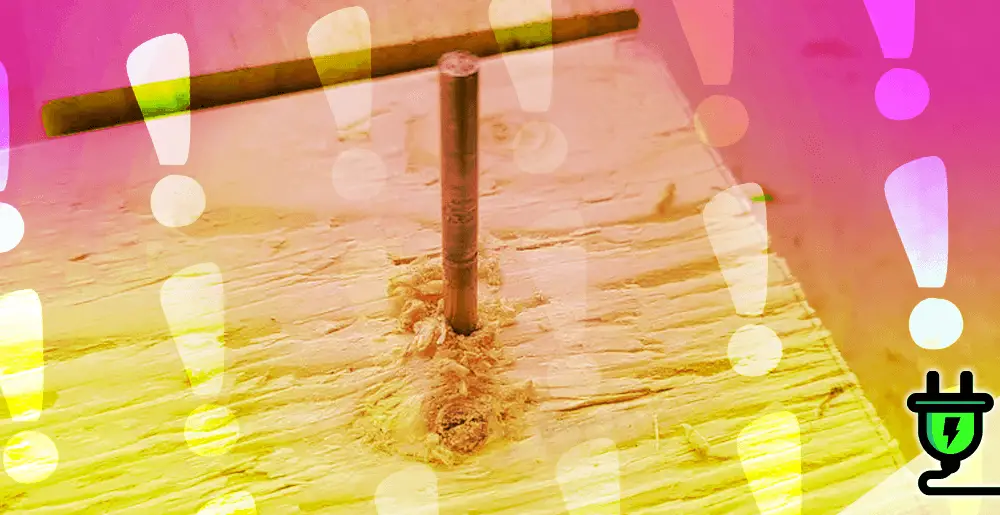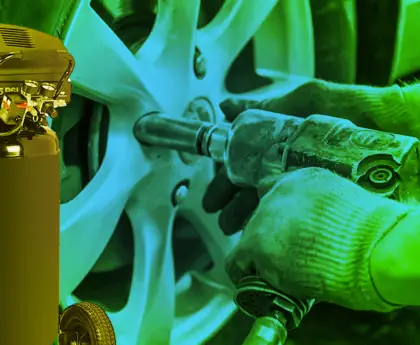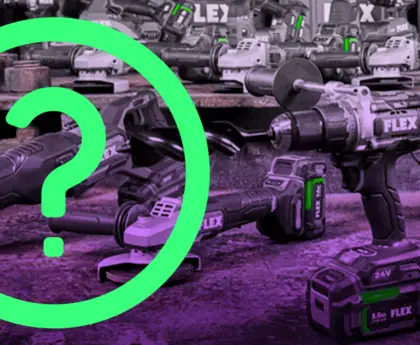If you’ve ever encountered the predicament of a drill bit stuck in wood, you know how frustrating it can be. Often caused by reasons such as improper tightening or using dull bits, this problem is more common than one might think.
To remove a stuck drill bit from wood, use pliers to grip the shank near the base and turn counter-clockwise to loosen. A little wiggling helps it come out, but if needed, keep using the pliers to unscrew it until it’s completely removed.
Removing a drill bit stuck in wood isn’t challenging, but it does take a little patience. In this guide, we will walk you through effective methods to remove a stuck drill bit and prevent future occurrences.
Read on for practical tips and strategies that’ll keep your woodworking projects hassle-free!
Methods to Remove a Stuck Drill Bit from Wood
To remove a stuck drill bit from wood, there are several effective methods that can be used. Let’s take a look at each.
Using pliers or locking pliers
To remove a stuck drill bit from wood, you can try using pliers or locking pliers. Grip the shank of the drill bit firmly with the pliers and turn it counterclockwise to loosen and remove it from the wood.
This method provides additional leverage and grip to help release the stuck drill bit. Remember to use a pair of pliers that are suitable for your specific needs, ensuring they have a strong grip and are properly sized for the job at hand.
Hammering a screwdriver against the drill bit
Hammering a screwdriver against the drill bit can help loosen it if it is stuck in wood. By using a hammer and a flat-headed screwdriver, you can apply force to dislodge the drill bit from its jammed position.
The impact of the hammer helps break free any debris or splintered wood that may be holding the drill bit in place. Be cautious not to use excessive force or hit too hard, as this could damage both the screwdriver and the drill bit.
It’s important to hold the drill steady while striking it with the hammer to prevent any accidental slips or injury.
Drilling from the opposite side
To remove a stuck drill bit from wood, one effective method is to try drilling from the opposite side. This technique can help dislodge the drill bit by creating an exit point for it in the wood.
By drilling a hole on the other side of the material, you provide an escape route for the stuck drill bit. It’s important to ensure that you align your new hole with precision and use proper drilling techniques to avoid any mishaps or damage to your project.
Give this method a try if you find yourself dealing with a stubbornly stuck drill bit in wood.
Using a screw extractor
To remove a stuck drill bit from wood, you can try using a screw extractor. A screw extractor is specifically designed to grip into the broken or stuck portion of the drill bit and then be turned counterclockwise to release it from the wood.
The tapered end of the screw extractor fits into a pre-drilled hole in the drill bit’s shank and provides extra torque for easy removal. By applying steady pressure and turning the screw extractor with pliers or a wrench, you can effectively extract the stuck drill bit from your wood material.
Using lubrication
Applying lubrication to a stuck drill bit can help loosen it from the wood. Lack of lubrication can cause friction between the drill bit and the wood, making it more difficult to remove.
By using a lubricant such as oil or WD-40, you can reduce friction and make it easier to extract the stuck drill bit.
Reasons for a Drill Bit Stuck in Wood
The drill bit can get stuck in wood due to improper tightening in the drill’s chuck, a dull or damaged drill bit, or excessive force or improper technique.
Improper tightening in the drill’s chuck
Securing the drill bit inaccurately in the chuck leads to numerous issues. The drill bit may wobble during operation causing uneven drilling and potential damage to your work piece.
Misalignment between the drill bit and chuck due to improper tightening can result in a stuck drill bit when you attempt to tighten it further. Overtightening, on the other hand, puts excessive strain on both parts, escalating chances of wear and tear leading inevitably towards it getting jammed or worse – breaking off completely while drilling into something as dense as wood.
Therefore, precise and firm securing of the drill bit within the chuck is a vital step in any drilling procedure to ensure effectiveness, safety, and longevity of your tools.
Dull or damaged drill bit
A dull or damaged drill bit can also lead to it getting stuck in wood. When a drill bit becomes dull, it loses its sharpness and effectiveness in cutting through the material. This can cause the bit to get stuck as it struggles to penetrate the wood properly.
Similarly, a damaged drill bit with chips or cracks can become lodged in the wood due to irregularities on its surface. Proper maintenance of your drill bits is essential to prevent them from becoming dull or damaged, ensuring smooth drilling and reducing the risk of them getting stuck in wood.
Excessive force or improper technique
Using excessive force or employing improper drilling techniques can cause a drill bit to get stuck in wood. When too much pressure is applied, the bit can become wedged in the material and refuse to budge.
Likewise, using incorrect drilling angles or not maintaining a steady grip on the drill can also lead to a stuck bit. It’s crucial to use the appropriate amount of force and ensure proper technique when drilling into wood to prevent bits from getting stuck.
Tips to Prevent Drill Bits from Getting Stuck in Wood
Use sharp drill bits to ensure clean and efficient drilling.
Use sharp drill bits
Sharp drill bits are essential for preventing them from getting stuck in wood. Dull or damaged drill bits are more likely to become lodged and cause frustration. By using sharp drill bits, you can ensure smoother drilling and reduce the risk of them getting stuck.
Regularly sharpening your drill bits will also help maintain their effectiveness and prevent unnecessary issues when working with wood.
Apply consistent, even pressure
Applying consistent, even pressure is crucial when using a drill to prevent the bit from getting stuck in wood. By maintaining a steady hand and exerting constant force, you can ensure that the drill bit goes smoothly through the material without jamming.
Uneven pressure or sudden jerks can cause the bit to bind and get stuck, leading to frustration and potential damage. Remember to hold the drill firmly but not too tightly, allowing for smooth movement as you work.
With proper technique and steady pressure, you can minimize the risk of a stuck drill bit and complete your woodworking projects with ease.
Use the appropriate drill bit for the material
Choosing the right drill bit for your project is essential to prevent a drill bit from getting stuck in wood. Different materials require different types of bits, such as twist drills for metal and spade or paddle bits for wood.
Using the wrong bit can cause the drill to bind in the material, making it difficult to remove. Make sure to select a drill bit that matches your material before starting your project to avoid any potential issues with a stuck drill bit.
Avoid excessive force
Excessive force is one of the common reasons why a drill bit gets stuck in wood. When you apply too much pressure or push too hard while drilling, the bit can become wedged tightly in the material.
This can make it difficult to remove and potentially cause damage to both the wood and the drill bit. It’s important to remember that using excessive force is not only unnecessary, but it can also lead to unwanted complications.
Taking a more controlled and measured approach when drilling into wood will help prevent your drill bit from getting stuck and ensure smoother and safer woodworking projects.
What to Do if the Drill Bit Breaks Off in the Wood
If the drill bit breaks off in the wood, assess the situation and carefully remove any loose fragments. Use a small drill or extractor specifically designed for broken bits to safely remove the remaining piece from the hole.
Once removed, fill and repair the hole as needed.
Assess the situation
To successfully handle a stuck drill bit in wood, it’s important to assess the situation. Check if the chuck is tightened properly or if the drill bit is dull or damaged. Consider whether excessive force or improper technique was used.
Evaluate if there is enough lubrication for smooth drilling. Assessing these factors will help determine the appropriate method to remove the stuck drill bit and prevent further damage to the wood and tool.
Keep in mind that prompt action is key to avoid complications like broken bits or jammed shavings in wet wood.
Use a small drill or extractor to remove the broken piece
To remove a broken piece of drill bit from wood, use a small drill or extractor. These tools are specifically designed to grip onto the broken piece and allow for easy removal. By attaching the drill or extractor to the remaining part of the broken drill bit, you can apply pressure and twist it counterclockwise to loosen and extract it from the wood.
This method is effective in safely retrieving the broken piece without causing further damage to your woodworking project.
Fill and repair the hole
To fill and repair the hole left behind after removing a stuck drill bit from wood, you can use various methods depending on the size and severity of the hole. One option is to fill the hole with wood filler or putty that matches the color of your wood.
Apply it evenly across the hole, smoothing it out with a putty knife. Once dry, you can sand it down for a seamless finish. Another option is to use wooden dowels or plugs to fill larger holes.
Simply cut them to size, apply some glue, and insert them into the hole until they are flush with the surface of the wood. Finally, if you have access to extra pieces of wood that match your project, you can patch up smaller holes by cutting out a piece in shape and size of the damaged area and gluing it in place.
When filling holes in wood after removing a stuck drill bit, make sure to follow manufacturer instructions for any products you use such as wood filler or glue. Additionally, always allow sufficient time for drying before sanding or painting over filled areas.
By properly filling and repairing any holes left behind from removing a stuck drill bit, you can restore your project’s appearance while ensuring its structural integrity remains intact.
Drill Bit Stuck In Wood FAQs
What should I do if a drill bit gets stuck in wood?
If a drill bit gets stuck in wood, you can try using pliers or vice grips to gently twist and pull it out. If that doesn’t work, you may need to use a drill bit extractor or seek help from a professional.
Can I remove a stuck drill bit without damaging the wood?
Yes, it is possible to remove a stuck drill bit without damaging the wood. By using gentle force and the right tools, such as pliers or a drill bit extractor, you can safely extract the stuck drill bit.
Why does a drill bit get stuck in wood?
A few reasons why a drill bit may get stuck in wood include excessive pressure while drilling, dull bits that are unable to cut effectively, or encountering knots or other hard spots in the wood.
How can I prevent a drill bit from getting stuck in wood?
To prevent a drill bit from getting stuck in wood, make sure to apply steady but controlled pressure while drilling. Use sharp bits appropriate for the type of material being drilled and avoid drilling into knots or other obstructions whenever possible.
Conclusion: Drill Bit Stuck In Wood
Without a doubt, a drill bit getting stuck in wood can be a frustrating experience. However, there are several methods available to remove the stuck drill bit and prevent it from happening again in the future.
By using the proper techniques and tools, such as pliers or screw extractors, you can successfully retrieve the stuck drill bit and continue with your woodworking projects. Remember to always use sharp drill bits and apply consistent pressure for smooth drilling.






